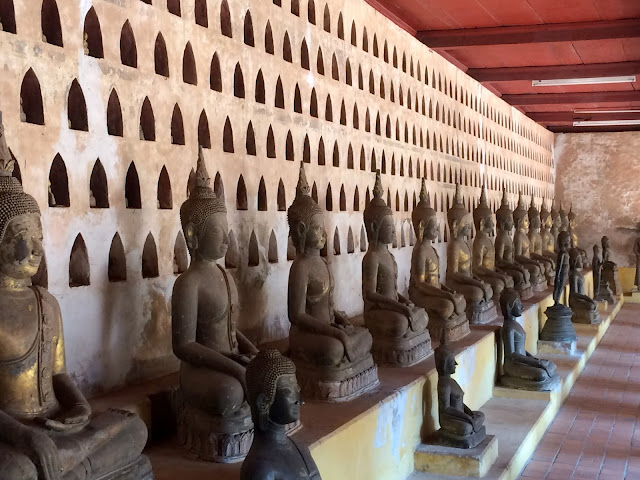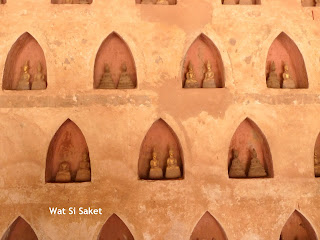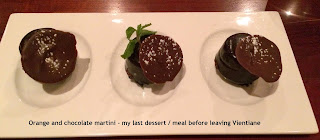
 Vientiane, the capital and largest city of Laos. Vientiane became the capital in 1563 due to fears of a Burmese invasion, but was later razed and looted to the ground in 1827 by the Siamese / Thai. Vientiane was the administrative capital during French rule and due to economic growth in recent times, is now the capital of Laos.
Vientiane, the capital and largest city of Laos. Vientiane became the capital in 1563 due to fears of a Burmese invasion, but was later razed and looted to the ground in 1827 by the Siamese / Thai. Vientiane was the administrative capital during French rule and due to economic growth in recent times, is now the capital of Laos. Vientiane has a recorded history that stretches back to around 1,000 AD. The area was originally settled because of the fertility of the surrounding alluvial plains. The total estimated population of the city prefecture is 760,000 (2015).

The city contains many temples and Buddhist monuments with Pha That Luang, a Buddhist stupa, one of the most famous in Laos. It is the important national cultural monument and very popular amongst foreign tourists.
The original was built in 1566 by King Setthathirath, and was restored in 1953. The golden stupa is 45 metres tall and is believed to contain a relic of the Lord Buddha. 10,000 kip Entrance fee (3,000 kip for Laotians).
Thanon That Luang is two kms east from Patuxai. That Luang is a three-layered gilded stupa. All days 08:00-17:00. Accessing the inner courtyard gives you a slightly closer view of the stupa, and lots of Buddha statues. Vientiane's most important festival, Bun That Luang, is held here in November on the night of the full moon.
Access to the complex is across a large square – you don’t really realise the size of the square or the complex until you are on the verge of crossing it. Then you feel its immenseness.
The visitor walks first to this imposing building which I call the Audience Hall. Its vast halls are empty except for a large Buddha statue at one end of a long hall. Each room is ornately painted in red and gold with scenes from Buddha’s life. Next, is the Pha That Luang which looks really pretty in the afternoon sunlight – gold reflecting of its dome and its spires. Being 01 May, a national holiday, it was closed unfortunately. Next to it is another hall which is where the monks eat and this again had many paintings all over the walls and ceiling. Nearby was a small building here I saw many standing Buddha figures and one reclining Buddha. It’s a large area and one takes one’s time enjoying the serenity and beauty of the place.


Patuxai (Victory
Gate), Avenue Lane Xang. The memorial monument, Patuxai, began construction in 1957 and was completed
in 1968. Its unusualness makes it a prominent landmark in the city. A local version of Paris' Arc de Triomphe.
While the Arc de Triomphe may
have inspired the architecture, the design incorporates typical Lao motifs
including “Kinnari”, a mythical bird woman. Energetic visitors can climb to the
top of the monument, which reveals a panoramic view of the city. It costs 3000
kip to climb to the top of the monument which is equivalent to 7 storeys and
you get a good view, so I am told!
Besides
the elaborate Buddhist embellishment, it differs from the original in having
four gates instead of two and being just a bit higher - to trump the French.
Reasonably impressive from afar, I was shocked to read an official plaque right
next to the entry stating it is a "monster of concrete" when seen up
close - and the concrete in question was donated by the US, although it was
supposed to go towards a new airport instead: hence the nickname "the
Vertical Runway".
Hophakaew Museum. This
place is spelt differently so initially I was confused. It has an entrance fee
5,000 kip. It is one of the three sights one visits here – the Museum, Si Saket
and the Palace are within minutes of each other. An elegant, and majestic structure, King
Setthathirat's former royal temple, which housed the magical Emerald Buddha (pha
kaew) after it was taken from Lanna (Chiang Mai).
The Siamese took it back in 1779 - the image is now housed in Bangkok's Wat Phra Kaew - and came back in 1828
to raze the temple for good measure. The present structure is a 1942
reconstruction and not much seems to be known about its fabrication.
 The temple no longer operates and the interior has been turned into a small
jumbled museum housing Buddha images. The most popular image is the beautiful
tall, lithe, long-armed Buddha in the hands-down "calling for rain"
pose. In the room with the various images, at one end there is a counter
selling Buddhist religious items and at the opposite end is the shrine. I managed
to take a photograph of it as the whole scene was so unexpected.
The temple no longer operates and the interior has been turned into a small
jumbled museum housing Buddha images. The most popular image is the beautiful
tall, lithe, long-armed Buddha in the hands-down "calling for rain"
pose. In the room with the various images, at one end there is a counter
selling Buddhist religious items and at the opposite end is the shrine. I managed
to take a photograph of it as the whole scene was so unexpected. 

 Wat Si Saket is now known as Sisaket Museum – no one knows why. I paid yet another entrance fee of 5,000 kip. This Wat is right opposite the Museum described above. It has a unique ambience. Very silent. Very peaceful. Like the Pindaya caves or Pak Ou caves, there are thousands of images of the Buddha here but all in very good order – laid straight out in perfect lines. There is a small room with a glass locked door where broken images are respectfully preserved. It could be the oldest standing temple in Vientiane and among the most atmospheric. Built in 1818 by Chao Anou in
the Bangkok style and hence left unsacked when much of Vientiane was razed in a
Siamese raid in 1828. As you enter, within the cloister walls are hundreds of
niches housing Buddha images large and small, made of wood, stone, silver and
bronze. In the centre of the courtyard is a five-tier-roofed sim (ordination
hall) housing yet more Buddha niches and beautiful but fading murals of the
Buddha's past lives. This small building has a large
volume near the entrance detailing in German and English most of the murals,
how they were preserved and their importance of the hand painted murals in Lao
history. Regrettably now the murals are not maintained.
Wat Si Saket is now known as Sisaket Museum – no one knows why. I paid yet another entrance fee of 5,000 kip. This Wat is right opposite the Museum described above. It has a unique ambience. Very silent. Very peaceful. Like the Pindaya caves or Pak Ou caves, there are thousands of images of the Buddha here but all in very good order – laid straight out in perfect lines. There is a small room with a glass locked door where broken images are respectfully preserved. It could be the oldest standing temple in Vientiane and among the most atmospheric. Built in 1818 by Chao Anou in
the Bangkok style and hence left unsacked when much of Vientiane was razed in a
Siamese raid in 1828. As you enter, within the cloister walls are hundreds of
niches housing Buddha images large and small, made of wood, stone, silver and
bronze. In the centre of the courtyard is a five-tier-roofed sim (ordination
hall) housing yet more Buddha niches and beautiful but fading murals of the
Buddha's past lives. This small building has a large
volume near the entrance detailing in German and English most of the murals,
how they were preserved and their importance of the hand painted murals in Lao
history. Regrettably now the murals are not maintained.
 |
the roof has intricate carving  |
Text and photographs copyright of the author. No part of this article or photographs maybe transmitted or reproduced by any means, electronic, mechanical, photocopying or otherwise, without written permission. Do contact the author on email -- helpthesun@gmail.com











































